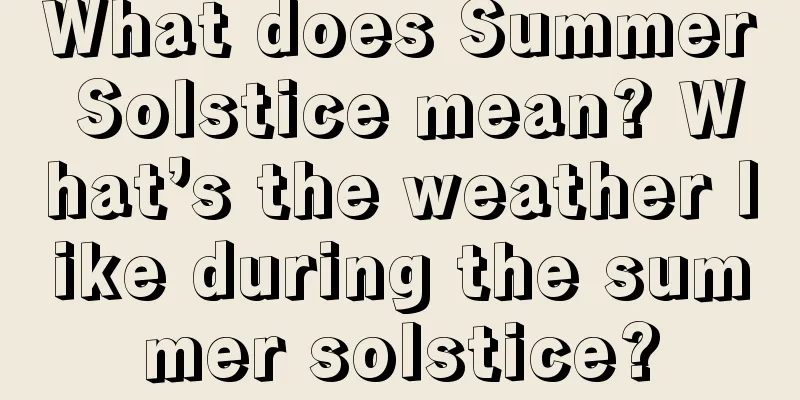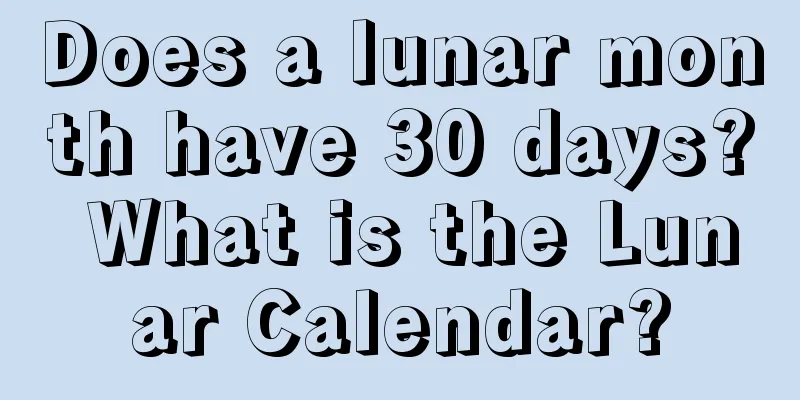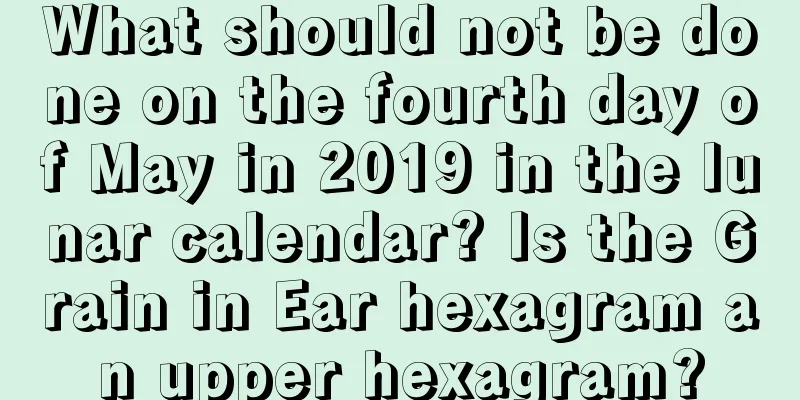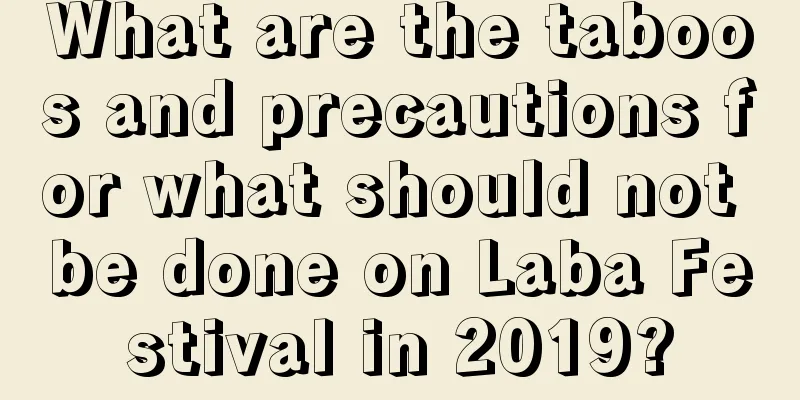What does Summer Solstice mean? What’s the weather like during the summer solstice?

The Summer Solstice is a festival that reflects weather changes. It was called the "Summer Solstice Festival" in ancient times. In order to celebrate this grand festival, people in ancient times often took holidays around the Summer Solstice. So what does the Summer Solstice mean? Let’s find out together. The fifth month of the lunar calendar is also known as: Midsummer, Pomegranate Month, Pu Month, and Gao Month. The fifth month of the lunar calendar means the arrival of summer. Let’s take a look at the fifth month of the lunar calendar in 2018 with the Fortune Teller website.What does Summer Solstice mean?The summer solstice is the time of the year with the longest daylight, but it is not the time of the year with the highest temperature because the earth's accumulated temperature is not high enough. The average temperature on the summer solstice in the middle and lower reaches of the Yellow River is 26℃, and the rainfall is 50 mm. At this time, the average temperature on Hainan Island is 28℃, the average temperature in northern Heilongjiang is 18℃, and the temperature difference between north and south is 10℃. The summer solstice is the period with the smallest temperature difference in the north.Ancient feudal dynasties held sacrificial ceremonies on the Summer Solstice. As far back as the Zhou Dynasty, grand ceremonies were held on the summer solstice and the dog days. In addition to killing animals as offerings, people would also dig square pools (square pools) in the ground to store water for the sacrifices, which were collectively called summer sacrifices. Until the Ming and Qing dynasties, summer sacrifices were still one of the main traditional festivals of the feudal dynasty. The Fangze (Ditan) built outside Andingmen in the northern suburbs of Beijing in the Ming Dynasty is a relic of the summer solstice sacrifice. The Summer Solstice marks the beginning of the busy season of summer harvest, summer planting and summer management. "As we enter June, the summer solstice, we must seize the golden season." We have to rush to harvest wheat and plant rice seedlings in time. “Harvesting wheat is like grabbing treasure, and planting rice is like taking an exam”, “Yesterday it was all yellow, today it is all green”. During the summer months, weather changes are more complicated. Common disastrous weather conditions include sustained high temperatures, hail, heavy rain, continuous rain, etc., which are not conducive to wheat harvest. Harvesting wheat is like seizing food from the mouth of the dragon, so we must be prepared to resist natural disasters. "When the summer solstice comes, the hoe never stops." We must speed up inter-row cultivation and weeding; weeds are very easy to grow under high temperature conditions and compete with crops for water and fertilizer. “The bite of weeds in farmland during summer is as severe as a poisonous snake bite”, weeds must be eliminated when they are young. What’s the weather like during the summer solstice?When the summer solstice arrives, the middle and lower reaches of the Yangtze River generally have entered the plum rain season. The plum rain season is characterized by high temperature, high humidity and little sunshine, which is the peak season for crop diseases and insect pests. According to "Jingchu Sui Shi Ji", on the day of the summer solstice, if the ashes made from burning chrysanthemum leaves are sprinkled on crops, the crops will not suffer from diseases and insect pests. Perhaps the chrysanthemum leaf ashes contain some kind of insecticide chemical component, so it became a kind of "pesticide" in ancient times.In ancient times, farmers divided the half month of the summer solstice into the first time (the first three days), the second time (the middle five days) and the last time (the last seven days). What farmers feared most was "rain in the middle of the time" and "thunder and rain at the end of the time" (Qing Jia Lu). These superstitious customs reflect the helpless situation of ancient farmers who had to "depend on the weather for their livelihood", because the thunder and rain in the half month after the summer solstice are mostly of the characteristics of plum rain, which does more harm than good to the growth of crops; and after the half month after the summer solstice, it is the hot summer season, and crops begin to need water, so farmers hope that God will rain in time after the Dragon Division Day (that is, the 20th day of the fifth lunar month). |
<<: What does “Summer Solstice Song” mean?
>>: What customs and practices are there during the Summer Solstice?
Recommend
Is March 23rd of the lunar calendar, the Year of the Rat, 2020, a good day in the lunar calendar?
Is March 23rd of the lunar calendar, the Year of t...
Feng Shui Tips for Attracting Wealth in 2017
Introduction: Do you want to improve your fortune...
The twelfth day of the sixth lunar month in 2018 is a good day?
The sixth month of the lunar calendar is the most...
Is December 28th of the lunar calendar in 2020 a good day to get married?
Is December 28th of the lunar calendar in 2020 a ...
Is the lunar calendar suitable for getting married during the Big Snow solar term in 2019? Is the hexagram auspicious?
Daxue is the 21st solar term in the year. The Daxu...
Is the ninth day of the twelfth lunar month in 2019 an auspicious day for signing a contract?
Is the ninth day of the twelfth lunar month in 201...
Is it possible to get married on the 14th day of the first lunar month in 2019?
The fourteenth day of the first lunar month is the...
Is the fate of a male dog born on March 23, 2018 in the lunar calendar good or bad?
Introduction: Although every child cannot choose t...
Can I open my business on the 16th day of the first lunar month in 2019? Is it a good day?
Why should we choose an auspicious day to open a b...
Is it good or bad if a relative dies during the Spring Festival? What are the customs of ancestor worship during the Spring Festival?
Introduction: The Spring Festival is a traditional...
Is it a good time to move house on the Cold Dew Day in 2019? Recommended proverbs about the Cold Dew Day!
Introduction: It is also necessary to choose an au...
Is New Year’s Eve a good time to move? What should I pay attention to when moving?
New Year's Eve refers to the last day of the l...
Is February 13, 2020 March 6 in the Gregorian calendar? Is it an auspicious day or an unlucky day?
To determine whether a day is an auspicious day, w...
When is the auspicious time for the 23rd day of the 12th month of the lunar year in 2021? What's the omen for this day?
The twelfth month of the lunar calendar marks the ...
Is the second day of the second lunar month in 2018 suitable for decoration? What day is the second day of the second lunar month?
Renovating and building a house is no longer a rar...









